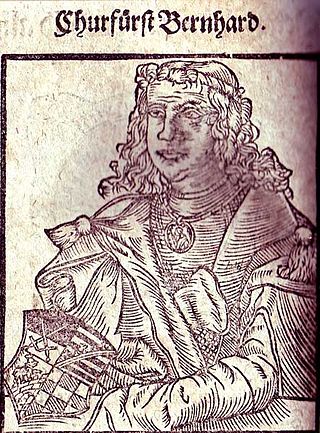Related Research Articles
A count palatine, also count of the palace or palsgrave, was originally an official attached to a royal or imperial palace or household and later a nobleman of a rank above that of an ordinary count. The title originated in the Late Roman Empire. In the Middle Ages especially and into modern times, it is associated with the Holy Roman Empire, especially Electoral Palatinate.

Eric III Lamb was King of Denmark from 1137 until 1146. He was the grandson of Eric I and the nephew of Eric II, whom he succeeded on the throne. He abdicated in 1146, and was the only Danish monarch to do so voluntarily, until Margrethe II, 878 years later in 2024. His succession led to a period of civil war between Sweyn III, Canute V, and Valdemar I.

Hermann I, Landgrave of Thuringia and Count Palatine of Saxony, was the second son of Louis II, Landgrave of Thuringia, and Judith of Hohenstaufen, the sister of Emperor Frederick Barbarossa.
Gertrud of Brunswick was Countess of Katlenburg by marriage to Dietrich II, Count of Katlenburg, Margravine of Frisia by marriage to Henry, Margrave of Frisia, and Margravine of Meissen by marriage to margrave Henry I.
Conrad I, called the Great, a member of the House of Wettin, was Margrave of Meissen from 1123 and Margrave of Lusatia from 1136 until his retirement in 1156. Initially a Saxon count, he became the ruler over large Imperial estates in the Eastern March and progenitor of the Saxon electors and kings.
Lothair Udo II was Margrave of the Nordmark from 1057 until his death and also Count of Stade. He was the only son of Lothair Udo I of the Udonids and Adelaide of Rheinfelden.

Gandersheim Abbey is a former house of secular canonesses (Frauenstift) in the present town of Bad Gandersheim in Lower Saxony, Germany. It was founded in 852 by Count Liudolf of Saxony and his wife, Oda, progenitors of the Liudolfing or Ottonian dynasty, whose rich endowments ensured its stability and prosperity.

Bernhard, a member of the House of Ascania, was Count of Anhalt and Ballenstedt, and Lord of Bernburg through his paternal inheritance. From 1180 he was also Duke of Saxony.
Jutta of Thuringia was the eldest daughter of Landgrave Hermann I of Thuringia and his first wife, Sophia of Sommerschenburg, a daughter of Fredrick II of Sommerschenburg.

Hedwig of Brandenburg, also called Hedwig of Ballenstedt, a member of the House of Ascania, was Margravine of Meissen from 1156 until 1190 by her marriage with Margrave Otto II.
Margrave Conrad II of Lusatia, also known as Margrave Konrad II of Landsberg, was a member of the House of Wettin. He was Count of Eilenburg and Margrave of Lusatia from 1190 until his death. From 1207, he was also Count of Groitz and Count of Sommerschenburg. He was a son of Margrave Dedi III and his wife, Matilda of Heinsberg, the heiress of Sommerschenburg.
Sophie of Winzenburg was the first Margravine of Brandenburg.
Herman I, Count of Winzenburg was count of Formbach and Radelberg. From 1109 to 1130, he was also Count of Winzenburg and from 1122 to 1138, he was Count of Reinhausen. He was also Landgrave of Thuringia from 1111 to 1130 and Margrave of Meissen from 1124 to 1130. And finally, he was high bailiff of Corvey Abbey.
Richenza was a German noblewoman. By her first marriage, she was Countess of Werl. By her second marriage, she was Countess of Northeim, and from 1061 to 1070, Duchess of Bavaria.
Herman II, Count of Winzenburg was a son of Herman I, Count of Winzenburg and his second wife, Hedwig. She was either Hedwig of Assel-Woltingerode or Hedwig of Carniola-Istria. Herman II succeeded his father as Count of Winzenburg, without achieving the dominant position his father had held. He was a loyal supporter of Archbishop Adalbert of Mainz for many years.
Rudolf I, Margrave of the Nordmark and Count of Stade, son of Lothair Udo II, Margrave of the Nordmark, and Oda of Werl, daughter of Herman III, Count of Werl, and Richenza of Swabia. Rudolf was the brother of his predecessors Henry I the Long and Lothair Udo III.
Udo IV, Margrave of the Nordmark and Count of Stade and Count of Freckleben, son of Rudolf I, Margrave of the Nordmark, and Richardis, daughter of Hermann von Sponheim, Burgrave of Magdeburg. It is unclear why he went by the abbreviated name of Udo as opposed to the traditional Lothair Udo of his ancestors.
Hartwig, Count of Stade and Archbishop of Bremen, son of Rudolf I, Margrave of the Nordmark, and Richardis, daughter of Hermann von Sponheim, Burgrave of Magdeburg.
Luitgard is a German female name.
Richardis von Stade was a German nun and Benedictine abbess of Bassum Abbey. She was a member of the Udonids family as the daughter of Rudolf I, Margrave of the Nordmark and Richardis; and the sister of Hartwig, Count of Stade and Archbishop of Bremen, and Lutgard of Salzwedel, Queen consort of Denmark, Adelheid and Udo. She is best known for her intimate friendship with Hildegard von Bingen.
References
- Alf Henrikson: Dansk historia (Danish history) (1989) (Swedish)
- Sven Rosborn (In Swedish): När hände vad i Nordens historia (When did what happen in the history of the Nordic countries) (1997)
- Hans Olrik, "Lutgard (Ljutgard), –1152, Dronning", in: Dansk biografisk leksikon , vol. X: Laale - Løvenørn, p. 400. (in Danish)